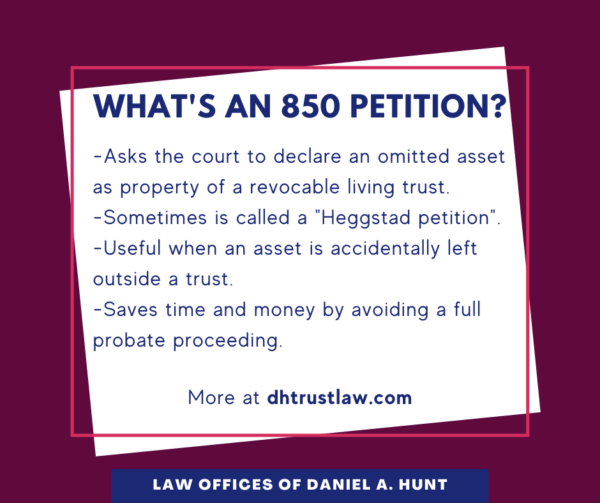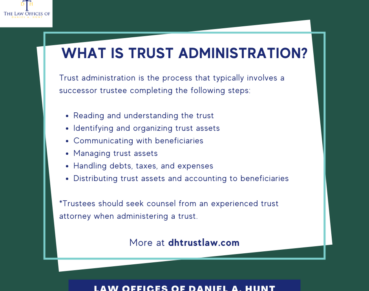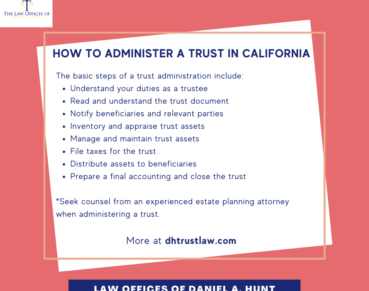What is an 850 petition?

What happens when a trustee dies without transferring all of their assets into their revocable living trust? This happens more often than it should when a trustee either forgets to transfer an asset into their trust or fails to do so properly. If the asset value exceeds the probate limit, their successor may need to file a California Probate in order to reclaim the asset. But to save time and money, consider using a petition under Probate Code Section 850 (also known as a Heggstad petition) instead.
What is an 850 petition?
A California Probate Code 850 petition (aka Heggstad petition) can be used when an asset is left out of a decedent’s revocable living trust. This may occur when the asset has not been appropriately titled in their trust even though the trust settlor intended the asset to be covered by the trust.
One common example is a trustee who refinances their home. The mortgage lender company usually takes the home out of the trust’s name to complete the refinance. If neither the company nor the trust settlor remembers to transfer the home back into the trust after the refinance, the home may trigger a probate proceeding when the trust settlor passes away.
Here’s another example: a person who creates a living trust, perhaps after realizing their health is deteriorating, but dies before they can fully transfer their assets into it. This may occur when the trust is created quickly at the end of a person’s life.
Normally, a trustee or beneficiary would need to open a probate in order to distribute or inherit the omitted asset. Fortunately, California Probate Code 850 allows for a shorter, less expensive option: filing a petition with the court to reclaim the property back into the trust. If the court grants the petition, the petitioner will receive a court order declaring the property as a trust asset.
Establishing Intent
To start the filing process, the trustee (or another interested person) should work with an experienced probate attorney. Your goal in filing an 850 petition is to prove the decedent’s intent to include the omitted asset in their revocable living trust.
How do you establish intent? Here are a few common ways:
- If the house was taken out of the trust for a refinance, show evidence (like a deed) that the real property had previously been transferred into a trust.
- If the asset was listed on the decedent’s Schedule of Assets when they created their trust, this shows clear intent to include the property in their trust.
- If one house was sold and the proceeds were used to purchase a new house that was omitted from the trust, use financial statements and witness affidavits to show that the new home was purchased with trust funds and establish the decedent’s intent to include it in the trust.
Information Needed to File an 850 Petition
As you work with your trust and estate attorney to prepare your petition for filing, you will need to locate the following documents:
- A copy of the decedent’s revocable living trust
- The trust’s Schedule of Assets (aka Schedule “A”)
- The property deed (if the omitted asset is real estate)
- Information about the decedent and their beneficiaries
- A copy of the decedent’s pour-over will that was lodged with the court.
Your attorney can provide guidance if you need help locating this information. If additional information is needed in order to file your petition, they will let you know.
How to File an 850 Petition
Here’s an outline of the basic process of filing an 850 petition:
- File a verified petition that states the relevant case facts and lists the names and addresses of all interested parties.
- The court will set a hearing date for the petition. The petitioner must give 30 days’ notice to all parties involved and personally serve notice to any party in physical possession of the property.
- Attend the court hearing. You’ll present documentation supporting your petition. Then the judge will make a final decision.
Most 850 petitions reach a decision within 60 days of filing, compared with 18 months or more for a probate). The total cost of an 850 petition varies, but on average runs around $4,000 to $5,000. Compared to the statutory probate fees of tens of thousands of dollars, an 850 petition can save significant time and money.
If you have any questions about filing an 850 petition, feel free to contact our law firm.
Law Offices of Daniel A. Hunt
The Law Offices of Daniel A. Hunt is a California law firm specializing in Estate Planning; Trust Administration & Litigation; Probate; and Conservatorships. We've helped over 10,000 clients find peace of mind. We serve clients throughout the greater Sacramento region and the state of California.




